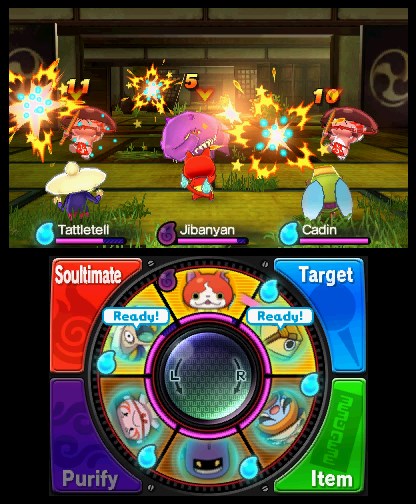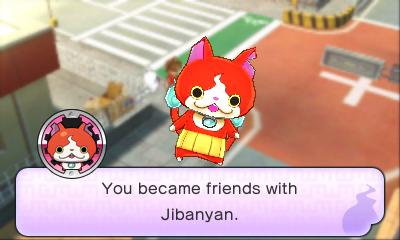Yo-kai is Why
In July 2013, the Yo-kai Watch franchise took Japan by storm. Beginning with a hit 3DS game from developers of Level-5 (of Professor Layton and Inazuma Eleven fame), the series became a phenomenon. The game was soon complemented by a hit anime series, a top-grossing movie, a trading card game, collectible medals from the game, and lots of toys and plushes in stores. A sequel even came out a year later. The most obvious parallel to this is the huge Pokémon craze back in the late-90s. Level-5 is obviously hoping to cash in on the craze in the West as well. Regardless of how the Yo-kai craze catches on, it remains clear that the first game is indeed a fun adventure. There are clear inspirations from Pokémon in Yo-kai Watch, and it shows in the game. However, Yo-kai Watch is also its own unique breed and does just enough to separate itself from the other monster-collecting behemoth series.
Story
The story of Yo-kai Watch plays out just like a Saturday morning cartoon. The main character Nate (or Katie) encounters Whisper, a Yo-kai resembling a ghost butler, in the forest. Whisper gives our hero the Yo-kai Watch, a special tool that allows its user to locate Yo-kai. The Yo-kai are supernatural creatures that are the reasons behind ordinary people’s issues. For instance, there are Yo-kai that force you to reveal secrets, that cause you to feel depressed, and that make you very hungry. While it is an interesting take on folk tales and superstition, a bulk of the game feels like it is just you trying to solve these mundane problems. You are not a superhero, nor are you trying to be the very best at something. There are no rivals and actual villains are few and seem to come out of nowhere. You are just there to react to odd phenomena and solve them. As a result, it rarely feels like there is much at stake.

There are multiple chapters in the game, but they are not related to each other. They act as episodic installments with each chapter featuring a different issue. Due to lack of continuity, the build-up to the end feels rushed. Likewise, while some of the individual chapters feel like complete anime episodes, some of them are 15-minute minigames that act as intermissions, making the game feel even shorter than it is.
Regardless, the game still manages to be humorous throughout. It is not afraid to make fun of itself and make light of the silly situations. Even if there is no epic plot or hero’s journey, the story still put a smile on my face with its zany characters, fun dialogue, and enjoyable world. Quirkiness is the story’s greatest strength.
Yo-kai
The Yo-kai are the big draws to this game, so being familiar with them is paramount to understanding the game as a whole. As previously discussed, Yo-kai are creatures that are behind ordinary problems. In a sense, they may explain why some people act in certain ways. If something is going on, there is probably a Yo-kai nearby. However, unlike Pokémon, Yo-kai are invisible creatures that can only be seen using a special lens on the Yo-kai Watch. This means that only the main character can see and interact with these creatures. This is fine, because also unlike Pokémon, Yo-kai can talk. In fact, the main Yo-kai partner, Whisper, actually serves as your chatty tutorial. While being the only one who can see Yo-kai may seem lonely, it also invokes the feeling of discovering this special supernatural world that is exclusive to you.

The designs of Yo-kai have an inherently Japanese feel to them. Many of them are based on actual Japanese ghosts and monsters of legend. They still have a cartoonish feel, preventing them from looking too scary. A good number of Yo-kai are quite cute, including one of the big mascots, the red cat Jibanyan. Some Yo-kai are cool-looking and represent some of the more interesting parts of Japanese culture, including a foxlike creature, a kappa, and a ninja. However, there are also a bunch of Yo-kai that are downright hideous or odd. For instance, Tattletell is a frail, old woman; Snotsolong is a bird with enormous snot coming out of its beak, resembling a mustache; and Cheeksqueek literally has a butt for a face. Parents, be warned: there is quite a bit of potty humor in some of the Yo-kai’s designs.

There are indeed quite a few Yo-kai, and finding a good group of them to be your partners can be difficult. There are over 200 creatures, already eclipsing the original Pokémon games’ bundle of 151. However, some color palette swaps make up quite a few of the species. Although the alternately colored Yo-kai have different stats, they do account for a good number, making the total Yo-kai count seem artificially high. In addition, some Yo-kai evolve and become a stronger, bigger version of themselves. The mechanics of this will be explained in the gameplay section.
Yo-kai vary in terms of rank, element, and tribe. Ranks go from E to S and define the relative strength of your Yo-kai. Each Yo-kai has a specific rank, meaning that the game is very honest about how weak starting Yo-kai are compared to their higher-ranking brethren. You will only be able to encounter lower-ranked Yo-kai in game, but you will gain the ability to find higher-ranked ones as the rank of your Yo-kai Watch goes up. Elements are similar to types in Pokémon and include fire, ice, and lightning. As one would expect from an element system, each element has a relative advantage and weakness. For example, fire is strong against ice but weak to water. This adds a rock-paper-scissors factor when deciding which Yo-kai to send out. Finally, Yo-kai belong to 1 of 8 tribes, with each tribe excelling in a different stat, such as the brave tribe consisting of strong attackers. There is certainly a lot to look at when determining which Yo-kai to use, which means a lot of time could be spent just deciding which of these unique creatures should be on your team.


Overall, Yo-kai are interesting and quirky, and the game itself makes fun of how some of them look. Regardless, the unique Japanese-based monsters are appealing and likable, and do not detract from the overall package at all.
Gameplay
Upon getting your Yo-kai Watch, you are free to explore the big bustling town of Springdale. In order to progress with the story, you must follow the objectives. In doing so, most of the game involves sensing Yo-kai that are causing trouble, battling them, possibly befriending them, and fighting bigger bosses. However, you are also free to explore. Unlike other RPGs such as Pokémon, you are limited to one town. This is actually fine, as it is a huge town with plenty to do. Each individual screen of the town is large, and you can walk into many of the buildings, alleyways, and caves. You can also embark on a handful of sidequests asking you to investigate people’s problems and requests, usually involving pesky Yo-kai. Having this much freedom gives the game a western-style, open-world feel.
Battling
Regardless of how you decide to spend your time in the game, you will undoubtedly spend a lot of that time battling other Yo-kai. By using the lens on your watch, you can search for hidden Yo-kai. Doing so engages a small minigame in which you must keep the Yo-kai in your sights for a certain amount of time. Upon completing the minigame, you then battle the Yo-kai.
In battles, you pit three of your Yo-kai at a time against up to three opposing Yo-kai. You do not have direct control of your Yo-kai during battles. Instead, they fight on their own, using one of their two possible attacks against whomever they decide to target. After each attack, Yo-kai wait a short time before automatically performing another attack. There are no menus to choose attacks or who should attack. A target system does allow you to have Yo-kai aim at a specific enemy. However, what they do is completely up to them. As a result, battles feel passive, as if running on auto-play. It would have been nice to at least have a simple menu of the Yo-kai’s normal attacks just to give the player some semblance of control.

That being said, there are some actions you can take to influence the battle. They all involve the touch-screen which actually has a nice, detailed user interface. Menu options for certain actions are presented in the corners with a large wheel of Yo-kai in the center. You can spin the Yo-kai Watch wheel to change which creatures are in front. If a certain Yo-kai in your team of six would do better, you can spin the wheel and instantly put it on the front lines. However, you cannot change a Yo-kai’s position in relation to those surrounding it. When you spin a Yo-kai to the front, you also spin the Yo-kai currently in front to the back. Three Yo-kai are always out in front, even if they have already fainted or have a status condition. Consequently, a Yo-kai’s position on your watch matters immensely. This makes the process of selecting and placing Yo-kai half the battle. You may consider putting a strong attacker next to status inducers or spreading healers between each attacker to balance out your team no matter the situation. Finally, placing two Yo-kai of the same tribe next to each other can provide a bonus significant enough to influence the battle. The continuous switching of Yo-kai can make battles more frenetic and strategic, even if half of the strategy is being prepared pre-battle.

Additionally, by building a Yo-kai’s spirit gauge, you can manually trigger a Soultimate, or special move. In order to activate the move, you play a quick minigame that involves either tapping buttons on the screen, tracing a design, or spinning a circle on the touch screen. These minigames give you something to do during the battle, but can get tiring, considering how often you must perform them.
Engaging in all of these battles unfortunately gets tedious, considering the auto-battle nature and constant touch-screen engagement. Luckily, boss battles spice it up. These bigger battles feature Yo-kai that are larger than life, requiring different strategies than simply switching in Yo-kai and performing Soultimates. Beating them requires smart use of the target system, aiming at specific parts of the boss to trigger openings. This is reminiscent of classic Zelda bosses in which you have to figure out how to defeat them and then mash away the moment you see a weak spot. Thus, boss battles are fresh, difficult experiences that break up the slog of normal battles.
Befriending and Evolving Yo-Kai
Befriending Yo-kai is unfortunately luck-based and somewhat difficult. In a system more similar to games like Dragon Quest Monsters, you must throw food at Yo-kai in the hopes that they will decide to join you following the battle. This is different from the Pokémon system in which you throw Pokéballs and receive instant feedback on whether you caught it or not. Instead, you must first defeat the Yo-kai and pray that it will approach you after the battle. If not, you will have to engage it again in another battle, using up more food and merely leaving it to luck. Some Yo-kai prefer different types of food, but that not easy to figure out without looking at a guide. Completionists beware: befriending Yo-kai takes a lot of time and effort to achieve.

Some Yo-kai can evolve as well. Methods of evolution include leveling-up and fusing with other Yo-kai or items. Fusion is an interesting function of evolution that is not dependent on level, but can result in some possible balance issues. Although you can only find higher-rank Yo-kai as your watch itself ranks up, you can easily synthesize two lower-ranked monsters and create monsters of a much higher rank. Abusing this system can break the game, assuming you were lucky enough to have the right fusion materials.
Multiplayer
Unfortunately, multiplayer is lacking as there is no online mode. While you can do battles against others locally, the auto-battle nature of this game makes the game somewhat luck-based. Nevertheless, having multiplayer at all is a good option in this game as it gives a reason to grind all your Yo-kai, provided you have someone to play against. The game also supports StreetPass, which actually has some good functionality. StreetPassing others allows you to fight and possibly recruit their Yo-kai (except for the higher ranked ones), which acts like a decent mini-multiiplayer battle.

Graphics and Sound
The graphics look wonderful for a 3DS game. The town is very vibrant and colorful, immersing you into its bustling world. A lot of detail is put into each character as well. All of the creatures are animated beautifully in an anime-style, making each Yo-kai feel lively. Soultimates also look particularly flashy and exciting. In addition to cutscenes using in-game assets effectively, there are also full anime cutscenes that look as if they were lifted from the show itself.

The music is upbeat and fits the cartoonish tone. Some songs have an eerie, mysterious vibe, adding to the ghoulishness of the Yo-kai. In particular, the battle music with its catchy tune and bass is fun to listen to. The voice acting, which matches the anime, all sound appropriate and are never annoying.
Playtime/Replayability
The main story mode takes anywhere from 20-30 hours, depending on how many sidequests you complete. Of course, like other games in its genre, the replay value is high as you could easily spend dozens more hours trying to get all 200+ Yo-kai, completing the 100+ quests, and grinding your team’s levels. Doing this will depend on enjoyment and commitment to the game’s mechanics, but those who enjoy it will surely find many hours of entertainment.

Conclusion
Yo-Kai Watch is a fresh take on the monster-collecting genre popularized by Pokémon. There are both good and bad deviations from the competition, but it is overall a fun experience that will please those looking for something similar to Pokémon. The Yo-kai have a Japanese appeal that may not attract everyone, but their unique quirkiness may just win western fans over. If the battle system and befriending mechanics were improved, it would leave a more positive overall impression. As it stands, this first iteration of Yo-kai Watch is a well-crafted, fun experience that is a great choice for younger players and something to consider for gamers who love the monster-collecting RPG genre.
Reblogged this on The Unofficial News, Reviews & Personal Views Blog Site On Nintendo and commented:
Hi everyone! Mr. Panda here, with a review of the Japanese monster-battling phenomenon, Yo-Kai Watch for 3DS! Yo-Kai Watch is a hit franchise in Japan, with popularity rivaling that of Pokemon during its glory days. Whether or not it will find success in the west is still to be determined. Nevertheless, the first game is now available in the west, so find out if it’s worth checking out in my review!
LikeLike
I did download the demo of this when it came out but… well, I couldn’t even finish the demo, I got so bored with the battle system. Perhaps it’s just not for me, haha. I’ll stick to the Pokemans. :-p
LikeLiked by 1 person
The passive battle system won’t please everyone, but it’s deeper than it seems on the surface. At the very least, it pleases its young Japanese audience. Like you, I got bored from the demo, but I don’t regret giving the game a try. It has a wit and charm about it that makes it more unique than a typical “Pokemon clone.”
LikeLike
Pokemon will always hold a special place in my heart. But I agree that there is something very charming (and very Japanese) about Yokai Watch. I do like that cute little Jibanyan. =^_^= Based on your review, I’d say it’s worth checking out. Nicely done!
LikeLiked by 1 person